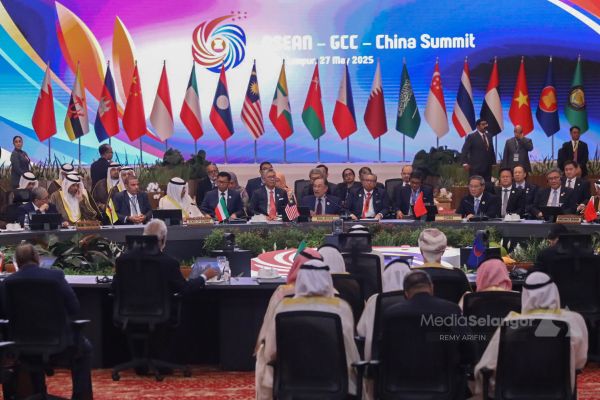By Danial Dzulkifly
KUALA LUMPUR, May 27 — The historic trilateral Asean-Gulf Cooperation Council (GCC)-China Summit signals a gradual shift in the global trade order, as the three regions seek to leverage each other’s strength amid geopolitical uncertainty and economic realignment triggered by sweeping United States tariffs.
Prime Minister Datuk Seri Anwar Ibrahim, in his summit opening address and in his capacity as Asean chair, urged the three parties to draw on their unique strengths and boost cooperation.
“Asean, GCC, and China collectively represent a combined gross domestic product of US$24.87 trillion and growing exponentially with a population of approximately 2.15 billion,” he said at the Kuala Lumpur Convention Centre here today.
“This collective scale offers vast opportunities to synergise our markets, deepen innovation, and promote cross-regional investment.
“I'm confident that Asean, GCC, and China can draw upon our unique attributes and shape a future that is more connected, more resilient, and more prosperous for generations to come.”
Anwar pointed out that Asean has long demonstrated that regionalism, rooted in consensus and mutual respect, can be successful. He said its lasting ties with the GCC and China provide a strong foundation to advance cooperation.
“Because of that, we have registered peace. (We are) one of the most peaceful regions and fastest-growing economies in the world.”
[caption id="attachment_402417" align="aligncenter" width="1025"] Delegates to the Asean-Gulf Cooperation Council-China Summit pose for a photo at the Kuala Lumpur Convention Centre on May 27, 2025. — Picture by REMY ARIFIN/MEDIA SELANGOR[/caption]
Delegates to the Asean-Gulf Cooperation Council-China Summit pose for a photo at the Kuala Lumpur Convention Centre on May 27, 2025. — Picture by REMY ARIFIN/MEDIA SELANGOR[/caption]
Anwar said the inaugural summit, themed “Synergising Economic Opportunities Towards Shared Prosperity”, aligns closely with Malaysia’s Asean chairmanship this year with its theme of “Inclusivity and Sustainability”.
He highlighted the enduring ties of the three parties that date back to the ancient Silk Road and maritime trade routes that helped shape centuries of commerce and cultural exchange.
“We have Makkah and Madinah as centres for millions of pilgrims. We have centres around Oman that became major trading routes in the region, and of course, we have the other countries in the GCC, as well as centres such as Melaka that exemplified this tradition, serving as vital crossroads linking east and west.”
Anwar said this legacy persists via strong economic links, with China remaining Asean’s largest trading partner in 2023 with trade valued at US$700 billion, while GCC-Asean trade stood at US$130.7 billion.
Foreign direct investment from China and the GCC into Asean reached US$17.3 billion and US$302 billion, respectively.
“These numbers signal not just strong existing linkages, but substantial untapped potential,” Anwar said.
He commended China’s transformation into a global economic powerhouse, highlighting its success in lifting millions out of poverty and its leadership in emerging technologies such as artificial intelligence (AI) and digitalisation.
He also lauded the GCC’s growing influence in finance, energy, and innovation, stressing its role as a rising hub for AI and digital development.




